Comprehensive Report on UK Employment Laws and Compliance
VerifiedAdded on 2023/06/15
|18
|4405
|417
Report
AI Summary
This report provides a comprehensive overview of UK employment laws, focusing on key aspects relevant to human resource management. It discusses the purpose of employment regulation, the roles of tribunals and courts, and methods for settling cases. The report delves into managing recruitment and selection activities, highlighting discrimination laws and the importance of employment contracts. It addresses managing change and reorganization, including contract variations, redundancy law, and business transfer requirements. Furthermore, it examines managing pay and working time, stakeholder rights, equal pay law, and key maternity and paternity laws. The report also covers treating staff lawfully, emphasizing health and safety law, implied duties, and freedom of association. Lastly, it discusses managing performance and disciplinary matters, unfair dismissal, and employee rights at hearings. This document is available on Desklib, a platform offering study tools and solved assignments for students.

Paraphrase This Document
Need a fresh take? Get an instant paraphrase of this document with our AI Paraphraser
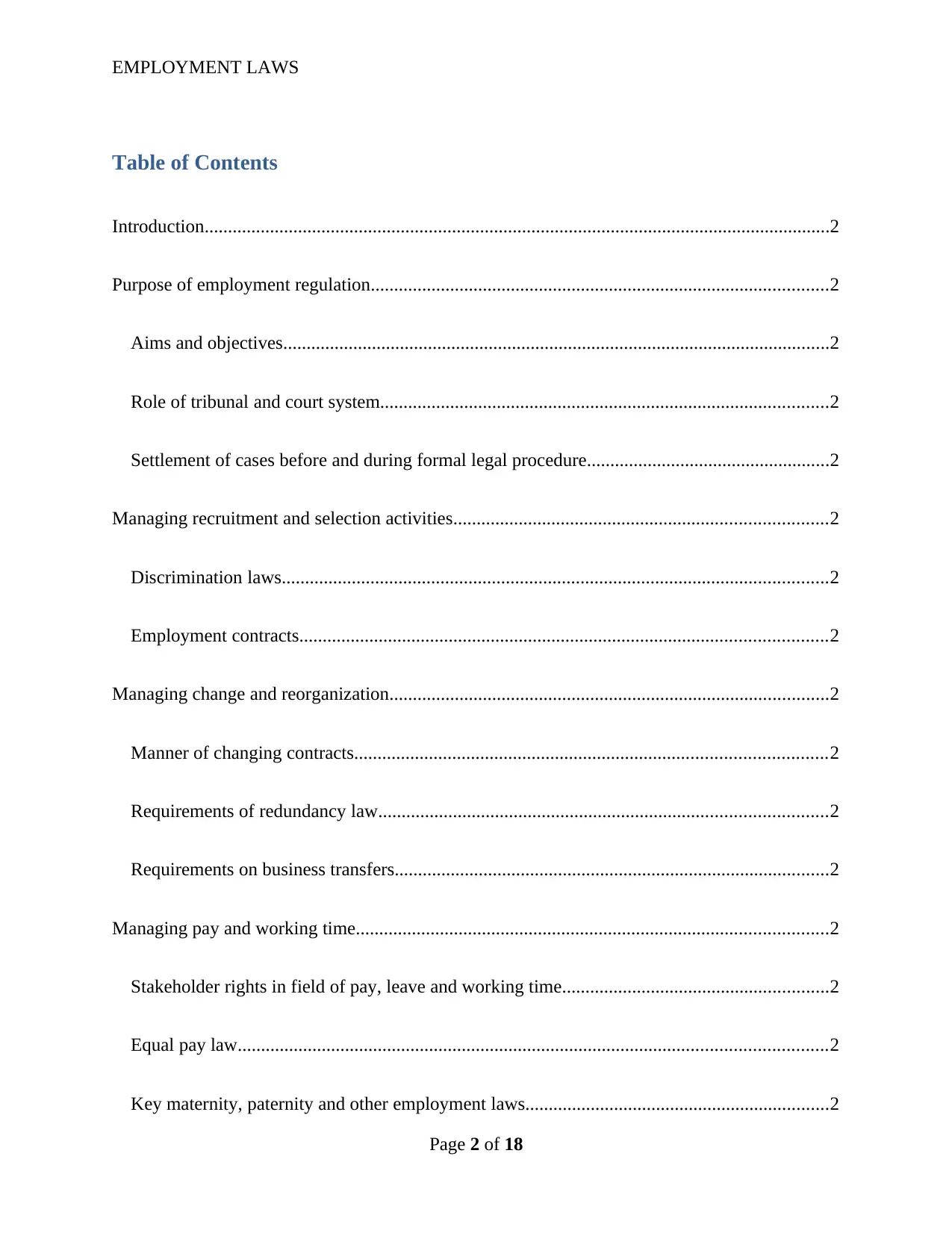
EMPLOYMENT LAWS
Table of Contents
Introduction......................................................................................................................................2
Purpose of employment regulation..................................................................................................2
Aims and objectives.....................................................................................................................2
Role of tribunal and court system................................................................................................2
Settlement of cases before and during formal legal procedure....................................................2
Managing recruitment and selection activities................................................................................2
Discrimination laws.....................................................................................................................2
Employment contracts.................................................................................................................2
Managing change and reorganization..............................................................................................2
Manner of changing contracts.....................................................................................................2
Requirements of redundancy law................................................................................................2
Requirements on business transfers.............................................................................................2
Managing pay and working time.....................................................................................................2
Stakeholder rights in field of pay, leave and working time.........................................................2
Equal pay law..............................................................................................................................2
Key maternity, paternity and other employment laws.................................................................2
Page 2 of 18
Table of Contents
Introduction......................................................................................................................................2
Purpose of employment regulation..................................................................................................2
Aims and objectives.....................................................................................................................2
Role of tribunal and court system................................................................................................2
Settlement of cases before and during formal legal procedure....................................................2
Managing recruitment and selection activities................................................................................2
Discrimination laws.....................................................................................................................2
Employment contracts.................................................................................................................2
Managing change and reorganization..............................................................................................2
Manner of changing contracts.....................................................................................................2
Requirements of redundancy law................................................................................................2
Requirements on business transfers.............................................................................................2
Managing pay and working time.....................................................................................................2
Stakeholder rights in field of pay, leave and working time.........................................................2
Equal pay law..............................................................................................................................2
Key maternity, paternity and other employment laws.................................................................2
Page 2 of 18
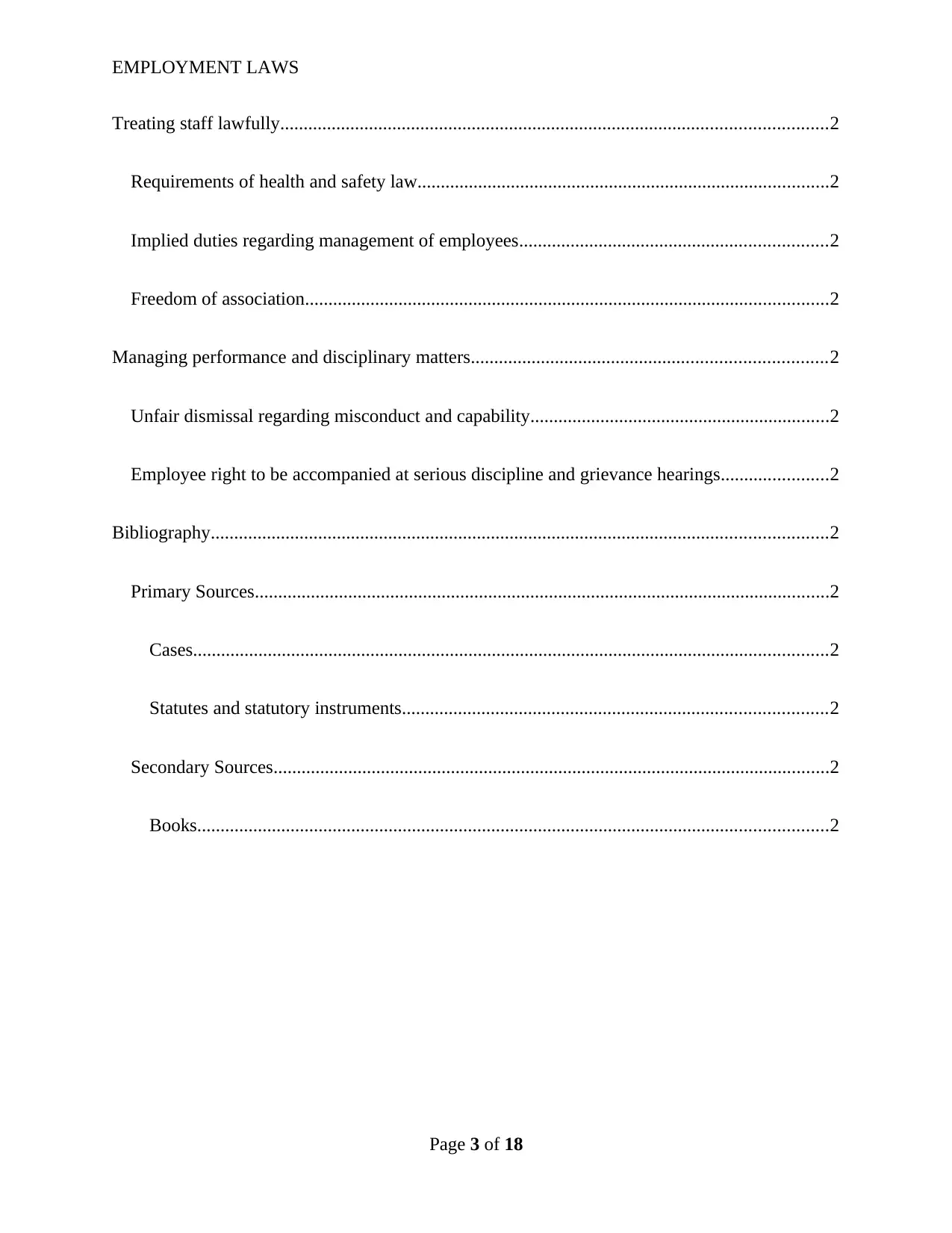
EMPLOYMENT LAWS
Treating staff lawfully.....................................................................................................................2
Requirements of health and safety law........................................................................................2
Implied duties regarding management of employees..................................................................2
Freedom of association................................................................................................................2
Managing performance and disciplinary matters............................................................................2
Unfair dismissal regarding misconduct and capability................................................................2
Employee right to be accompanied at serious discipline and grievance hearings.......................2
Bibliography....................................................................................................................................2
Primary Sources...........................................................................................................................2
Cases........................................................................................................................................2
Statutes and statutory instruments...........................................................................................2
Secondary Sources.......................................................................................................................2
Books.......................................................................................................................................2
Page 3 of 18
Treating staff lawfully.....................................................................................................................2
Requirements of health and safety law........................................................................................2
Implied duties regarding management of employees..................................................................2
Freedom of association................................................................................................................2
Managing performance and disciplinary matters............................................................................2
Unfair dismissal regarding misconduct and capability................................................................2
Employee right to be accompanied at serious discipline and grievance hearings.......................2
Bibliography....................................................................................................................................2
Primary Sources...........................................................................................................................2
Cases........................................................................................................................................2
Statutes and statutory instruments...........................................................................................2
Secondary Sources.......................................................................................................................2
Books.......................................................................................................................................2
Page 3 of 18
⊘ This is a preview!⊘
Do you want full access?
Subscribe today to unlock all pages.

Trusted by 1+ million students worldwide
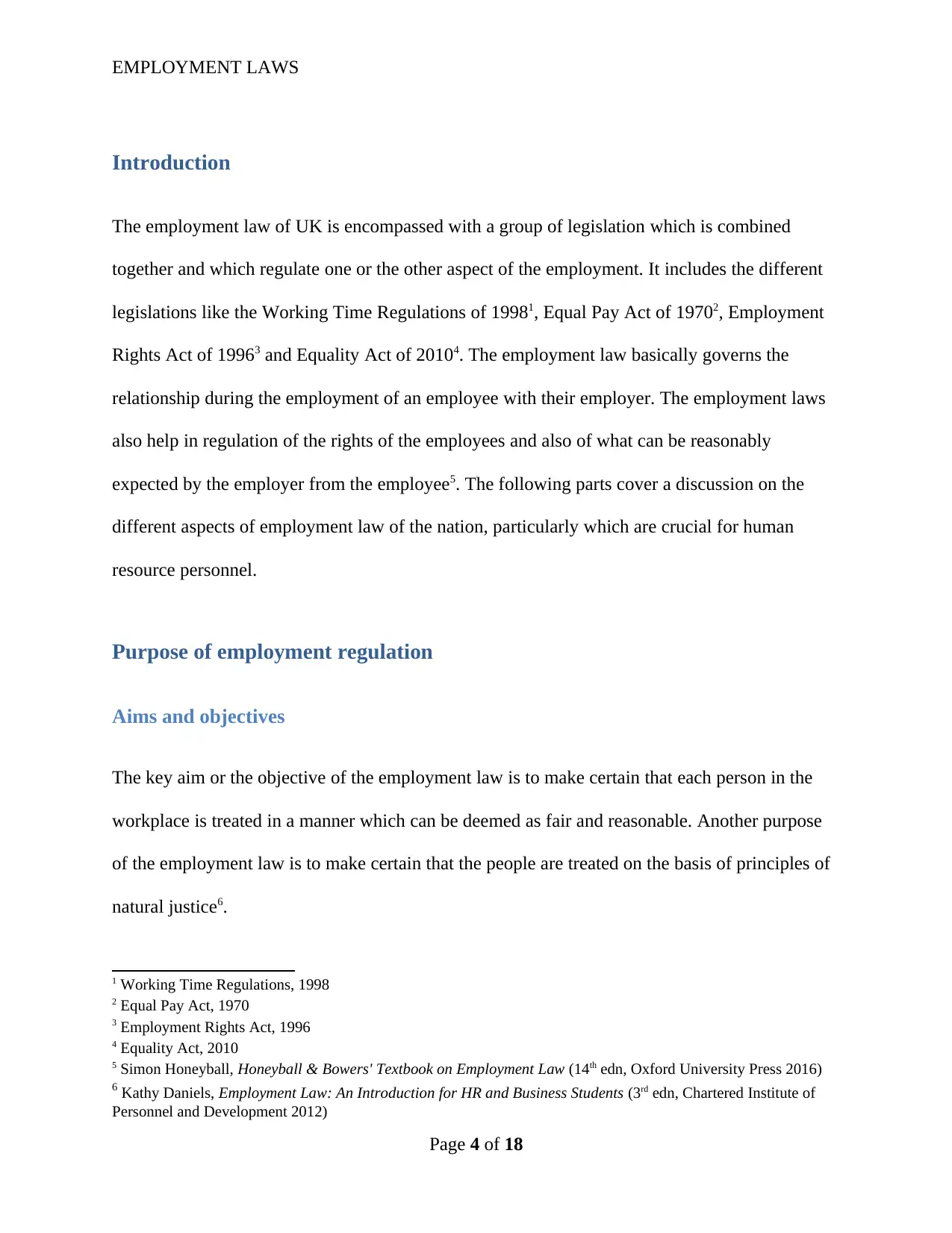
EMPLOYMENT LAWS
Introduction
The employment law of UK is encompassed with a group of legislation which is combined
together and which regulate one or the other aspect of the employment. It includes the different
legislations like the Working Time Regulations of 19981, Equal Pay Act of 19702, Employment
Rights Act of 19963 and Equality Act of 20104. The employment law basically governs the
relationship during the employment of an employee with their employer. The employment laws
also help in regulation of the rights of the employees and also of what can be reasonably
expected by the employer from the employee5. The following parts cover a discussion on the
different aspects of employment law of the nation, particularly which are crucial for human
resource personnel.
Purpose of employment regulation
Aims and objectives
The key aim or the objective of the employment law is to make certain that each person in the
workplace is treated in a manner which can be deemed as fair and reasonable. Another purpose
of the employment law is to make certain that the people are treated on the basis of principles of
natural justice6.
1 Working Time Regulations, 1998
2 Equal Pay Act, 1970
3 Employment Rights Act, 1996
4 Equality Act, 2010
5 Simon Honeyball, Honeyball & Bowers' Textbook on Employment Law (14th edn, Oxford University Press 2016)
6 Kathy Daniels, Employment Law: An Introduction for HR and Business Students (3rd edn, Chartered Institute of
Personnel and Development 2012)
Page 4 of 18
Introduction
The employment law of UK is encompassed with a group of legislation which is combined
together and which regulate one or the other aspect of the employment. It includes the different
legislations like the Working Time Regulations of 19981, Equal Pay Act of 19702, Employment
Rights Act of 19963 and Equality Act of 20104. The employment law basically governs the
relationship during the employment of an employee with their employer. The employment laws
also help in regulation of the rights of the employees and also of what can be reasonably
expected by the employer from the employee5. The following parts cover a discussion on the
different aspects of employment law of the nation, particularly which are crucial for human
resource personnel.
Purpose of employment regulation
Aims and objectives
The key aim or the objective of the employment law is to make certain that each person in the
workplace is treated in a manner which can be deemed as fair and reasonable. Another purpose
of the employment law is to make certain that the people are treated on the basis of principles of
natural justice6.
1 Working Time Regulations, 1998
2 Equal Pay Act, 1970
3 Employment Rights Act, 1996
4 Equality Act, 2010
5 Simon Honeyball, Honeyball & Bowers' Textbook on Employment Law (14th edn, Oxford University Press 2016)
6 Kathy Daniels, Employment Law: An Introduction for HR and Business Students (3rd edn, Chartered Institute of
Personnel and Development 2012)
Page 4 of 18
Paraphrase This Document
Need a fresh take? Get an instant paraphrase of this document with our AI Paraphraser
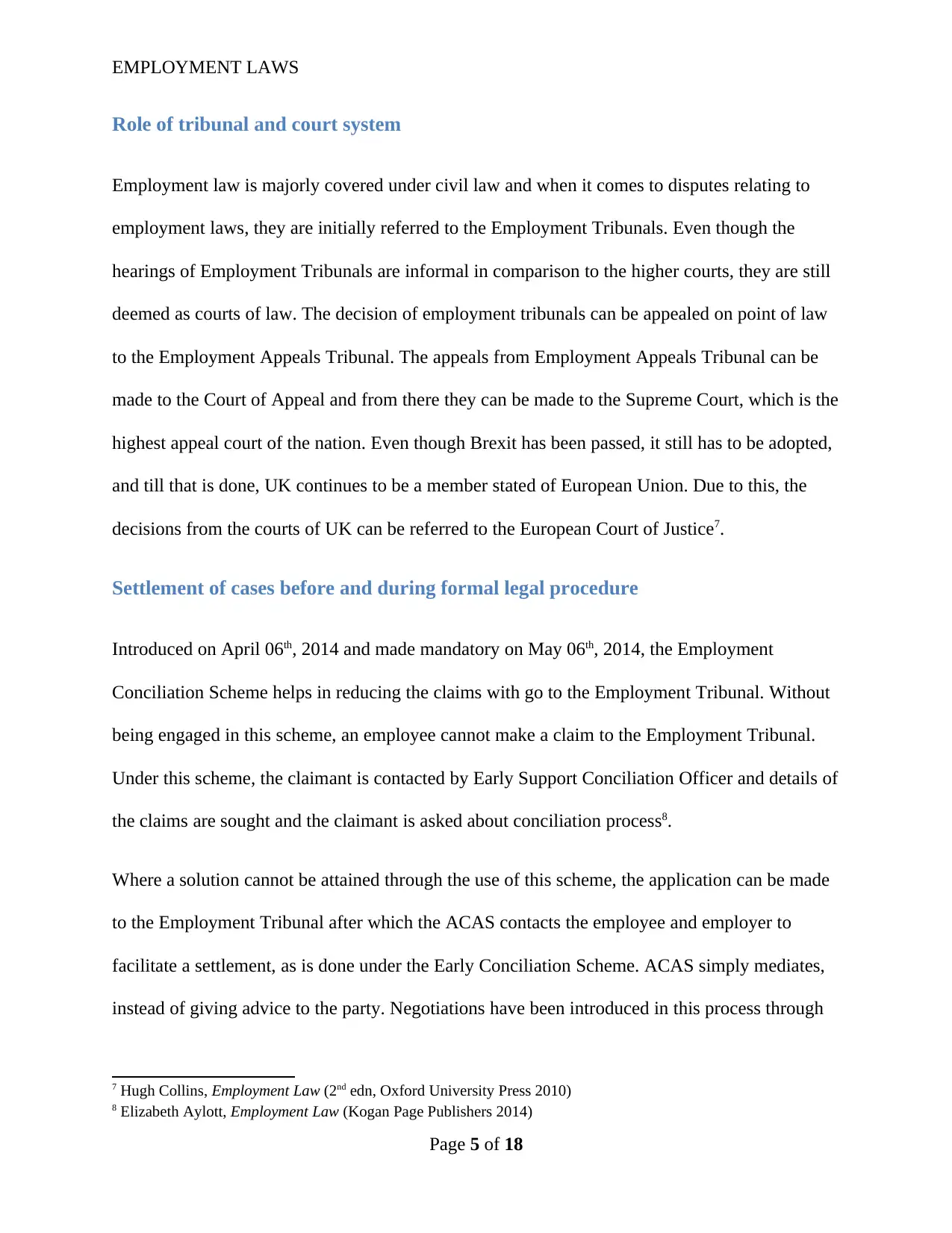
EMPLOYMENT LAWS
Role of tribunal and court system
Employment law is majorly covered under civil law and when it comes to disputes relating to
employment laws, they are initially referred to the Employment Tribunals. Even though the
hearings of Employment Tribunals are informal in comparison to the higher courts, they are still
deemed as courts of law. The decision of employment tribunals can be appealed on point of law
to the Employment Appeals Tribunal. The appeals from Employment Appeals Tribunal can be
made to the Court of Appeal and from there they can be made to the Supreme Court, which is the
highest appeal court of the nation. Even though Brexit has been passed, it still has to be adopted,
and till that is done, UK continues to be a member stated of European Union. Due to this, the
decisions from the courts of UK can be referred to the European Court of Justice7.
Settlement of cases before and during formal legal procedure
Introduced on April 06th, 2014 and made mandatory on May 06th, 2014, the Employment
Conciliation Scheme helps in reducing the claims with go to the Employment Tribunal. Without
being engaged in this scheme, an employee cannot make a claim to the Employment Tribunal.
Under this scheme, the claimant is contacted by Early Support Conciliation Officer and details of
the claims are sought and the claimant is asked about conciliation process8.
Where a solution cannot be attained through the use of this scheme, the application can be made
to the Employment Tribunal after which the ACAS contacts the employee and employer to
facilitate a settlement, as is done under the Early Conciliation Scheme. ACAS simply mediates,
instead of giving advice to the party. Negotiations have been introduced in this process through
7 Hugh Collins, Employment Law (2nd edn, Oxford University Press 2010)
8 Elizabeth Aylott, Employment Law (Kogan Page Publishers 2014)
Page 5 of 18
Role of tribunal and court system
Employment law is majorly covered under civil law and when it comes to disputes relating to
employment laws, they are initially referred to the Employment Tribunals. Even though the
hearings of Employment Tribunals are informal in comparison to the higher courts, they are still
deemed as courts of law. The decision of employment tribunals can be appealed on point of law
to the Employment Appeals Tribunal. The appeals from Employment Appeals Tribunal can be
made to the Court of Appeal and from there they can be made to the Supreme Court, which is the
highest appeal court of the nation. Even though Brexit has been passed, it still has to be adopted,
and till that is done, UK continues to be a member stated of European Union. Due to this, the
decisions from the courts of UK can be referred to the European Court of Justice7.
Settlement of cases before and during formal legal procedure
Introduced on April 06th, 2014 and made mandatory on May 06th, 2014, the Employment
Conciliation Scheme helps in reducing the claims with go to the Employment Tribunal. Without
being engaged in this scheme, an employee cannot make a claim to the Employment Tribunal.
Under this scheme, the claimant is contacted by Early Support Conciliation Officer and details of
the claims are sought and the claimant is asked about conciliation process8.
Where a solution cannot be attained through the use of this scheme, the application can be made
to the Employment Tribunal after which the ACAS contacts the employee and employer to
facilitate a settlement, as is done under the Early Conciliation Scheme. ACAS simply mediates,
instead of giving advice to the party. Negotiations have been introduced in this process through
7 Hugh Collins, Employment Law (2nd edn, Oxford University Press 2010)
8 Elizabeth Aylott, Employment Law (Kogan Page Publishers 2014)
Page 5 of 18
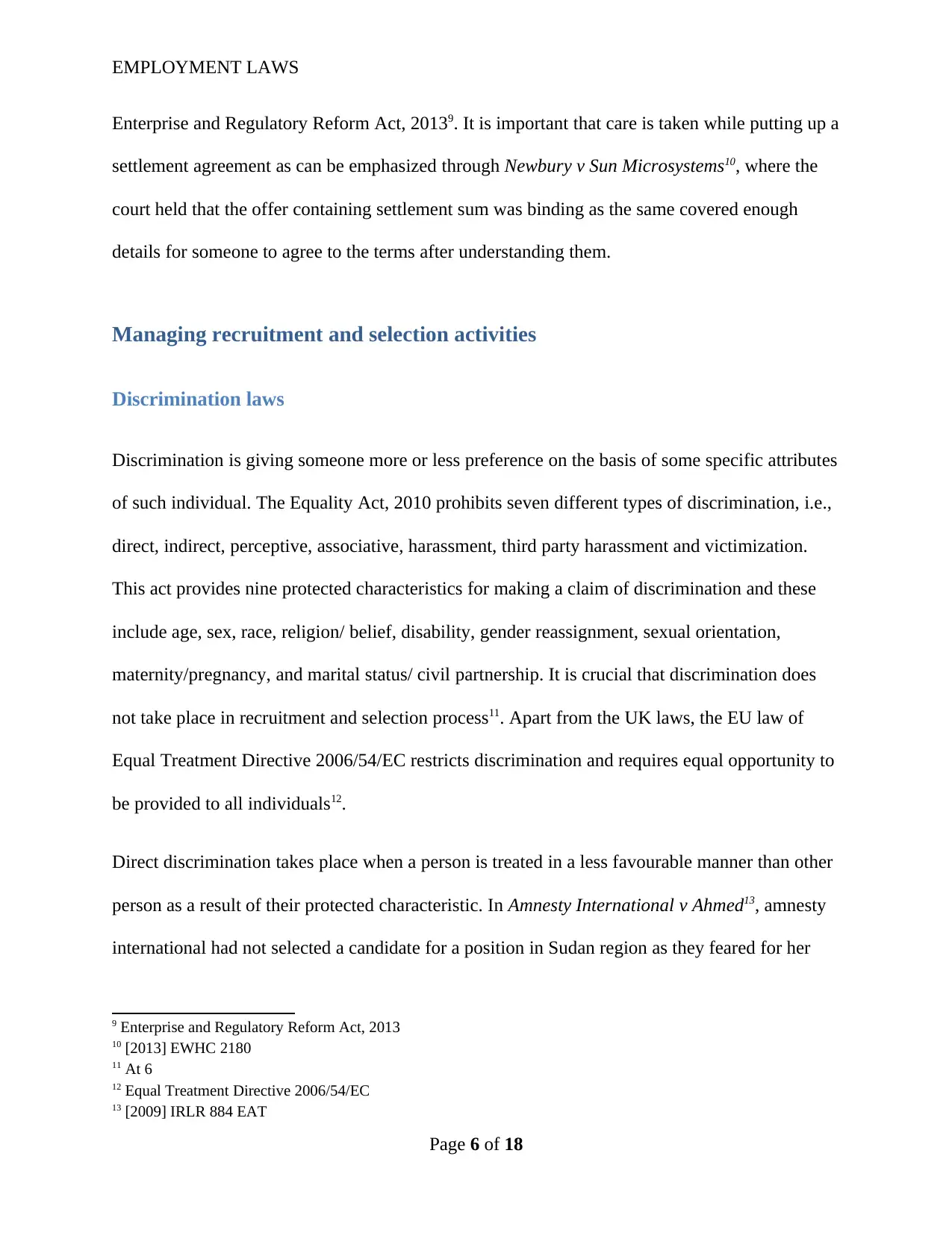
EMPLOYMENT LAWS
Enterprise and Regulatory Reform Act, 20139. It is important that care is taken while putting up a
settlement agreement as can be emphasized through Newbury v Sun Microsystems10, where the
court held that the offer containing settlement sum was binding as the same covered enough
details for someone to agree to the terms after understanding them.
Managing recruitment and selection activities
Discrimination laws
Discrimination is giving someone more or less preference on the basis of some specific attributes
of such individual. The Equality Act, 2010 prohibits seven different types of discrimination, i.e.,
direct, indirect, perceptive, associative, harassment, third party harassment and victimization.
This act provides nine protected characteristics for making a claim of discrimination and these
include age, sex, race, religion/ belief, disability, gender reassignment, sexual orientation,
maternity/pregnancy, and marital status/ civil partnership. It is crucial that discrimination does
not take place in recruitment and selection process11. Apart from the UK laws, the EU law of
Equal Treatment Directive 2006/54/EC restricts discrimination and requires equal opportunity to
be provided to all individuals12.
Direct discrimination takes place when a person is treated in a less favourable manner than other
person as a result of their protected characteristic. In Amnesty International v Ahmed13, amnesty
international had not selected a candidate for a position in Sudan region as they feared for her
9 Enterprise and Regulatory Reform Act, 2013
10 [2013] EWHC 2180
11 At 6
12 Equal Treatment Directive 2006/54/EC
13 [2009] IRLR 884 EAT
Page 6 of 18
Enterprise and Regulatory Reform Act, 20139. It is important that care is taken while putting up a
settlement agreement as can be emphasized through Newbury v Sun Microsystems10, where the
court held that the offer containing settlement sum was binding as the same covered enough
details for someone to agree to the terms after understanding them.
Managing recruitment and selection activities
Discrimination laws
Discrimination is giving someone more or less preference on the basis of some specific attributes
of such individual. The Equality Act, 2010 prohibits seven different types of discrimination, i.e.,
direct, indirect, perceptive, associative, harassment, third party harassment and victimization.
This act provides nine protected characteristics for making a claim of discrimination and these
include age, sex, race, religion/ belief, disability, gender reassignment, sexual orientation,
maternity/pregnancy, and marital status/ civil partnership. It is crucial that discrimination does
not take place in recruitment and selection process11. Apart from the UK laws, the EU law of
Equal Treatment Directive 2006/54/EC restricts discrimination and requires equal opportunity to
be provided to all individuals12.
Direct discrimination takes place when a person is treated in a less favourable manner than other
person as a result of their protected characteristic. In Amnesty International v Ahmed13, amnesty
international had not selected a candidate for a position in Sudan region as they feared for her
9 Enterprise and Regulatory Reform Act, 2013
10 [2013] EWHC 2180
11 At 6
12 Equal Treatment Directive 2006/54/EC
13 [2009] IRLR 884 EAT
Page 6 of 18
⊘ This is a preview!⊘
Do you want full access?
Subscribe today to unlock all pages.

Trusted by 1+ million students worldwide
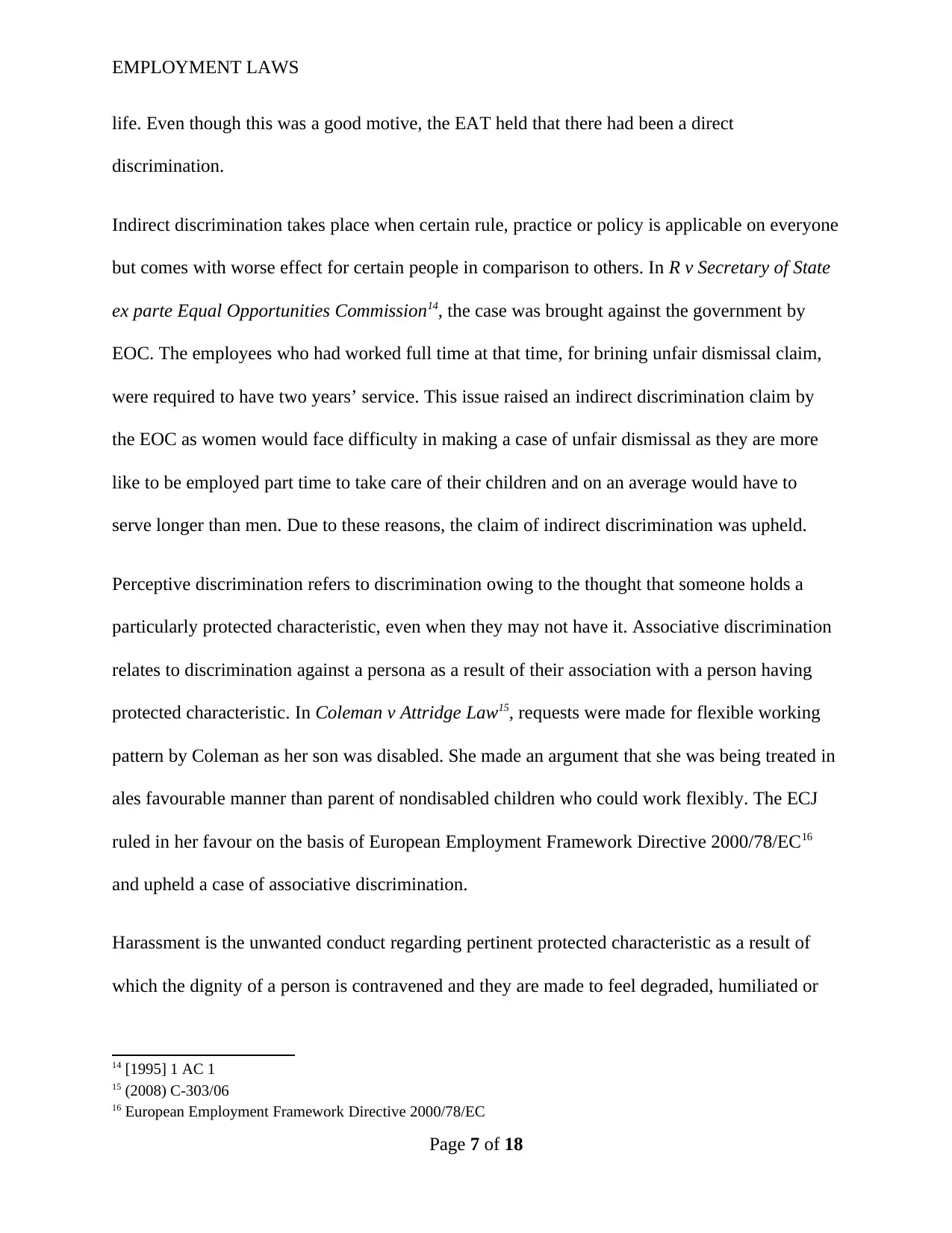
EMPLOYMENT LAWS
life. Even though this was a good motive, the EAT held that there had been a direct
discrimination.
Indirect discrimination takes place when certain rule, practice or policy is applicable on everyone
but comes with worse effect for certain people in comparison to others. In R v Secretary of State
ex parte Equal Opportunities Commission14, the case was brought against the government by
EOC. The employees who had worked full time at that time, for brining unfair dismissal claim,
were required to have two years’ service. This issue raised an indirect discrimination claim by
the EOC as women would face difficulty in making a case of unfair dismissal as they are more
like to be employed part time to take care of their children and on an average would have to
serve longer than men. Due to these reasons, the claim of indirect discrimination was upheld.
Perceptive discrimination refers to discrimination owing to the thought that someone holds a
particularly protected characteristic, even when they may not have it. Associative discrimination
relates to discrimination against a persona as a result of their association with a person having
protected characteristic. In Coleman v Attridge Law15, requests were made for flexible working
pattern by Coleman as her son was disabled. She made an argument that she was being treated in
ales favourable manner than parent of nondisabled children who could work flexibly. The ECJ
ruled in her favour on the basis of European Employment Framework Directive 2000/78/EC16
and upheld a case of associative discrimination.
Harassment is the unwanted conduct regarding pertinent protected characteristic as a result of
which the dignity of a person is contravened and they are made to feel degraded, humiliated or
14 [1995] 1 AC 1
15 (2008) C-303/06
16 European Employment Framework Directive 2000/78/EC
Page 7 of 18
life. Even though this was a good motive, the EAT held that there had been a direct
discrimination.
Indirect discrimination takes place when certain rule, practice or policy is applicable on everyone
but comes with worse effect for certain people in comparison to others. In R v Secretary of State
ex parte Equal Opportunities Commission14, the case was brought against the government by
EOC. The employees who had worked full time at that time, for brining unfair dismissal claim,
were required to have two years’ service. This issue raised an indirect discrimination claim by
the EOC as women would face difficulty in making a case of unfair dismissal as they are more
like to be employed part time to take care of their children and on an average would have to
serve longer than men. Due to these reasons, the claim of indirect discrimination was upheld.
Perceptive discrimination refers to discrimination owing to the thought that someone holds a
particularly protected characteristic, even when they may not have it. Associative discrimination
relates to discrimination against a persona as a result of their association with a person having
protected characteristic. In Coleman v Attridge Law15, requests were made for flexible working
pattern by Coleman as her son was disabled. She made an argument that she was being treated in
ales favourable manner than parent of nondisabled children who could work flexibly. The ECJ
ruled in her favour on the basis of European Employment Framework Directive 2000/78/EC16
and upheld a case of associative discrimination.
Harassment is the unwanted conduct regarding pertinent protected characteristic as a result of
which the dignity of a person is contravened and they are made to feel degraded, humiliated or
14 [1995] 1 AC 1
15 (2008) C-303/06
16 European Employment Framework Directive 2000/78/EC
Page 7 of 18
Paraphrase This Document
Need a fresh take? Get an instant paraphrase of this document with our AI Paraphraser
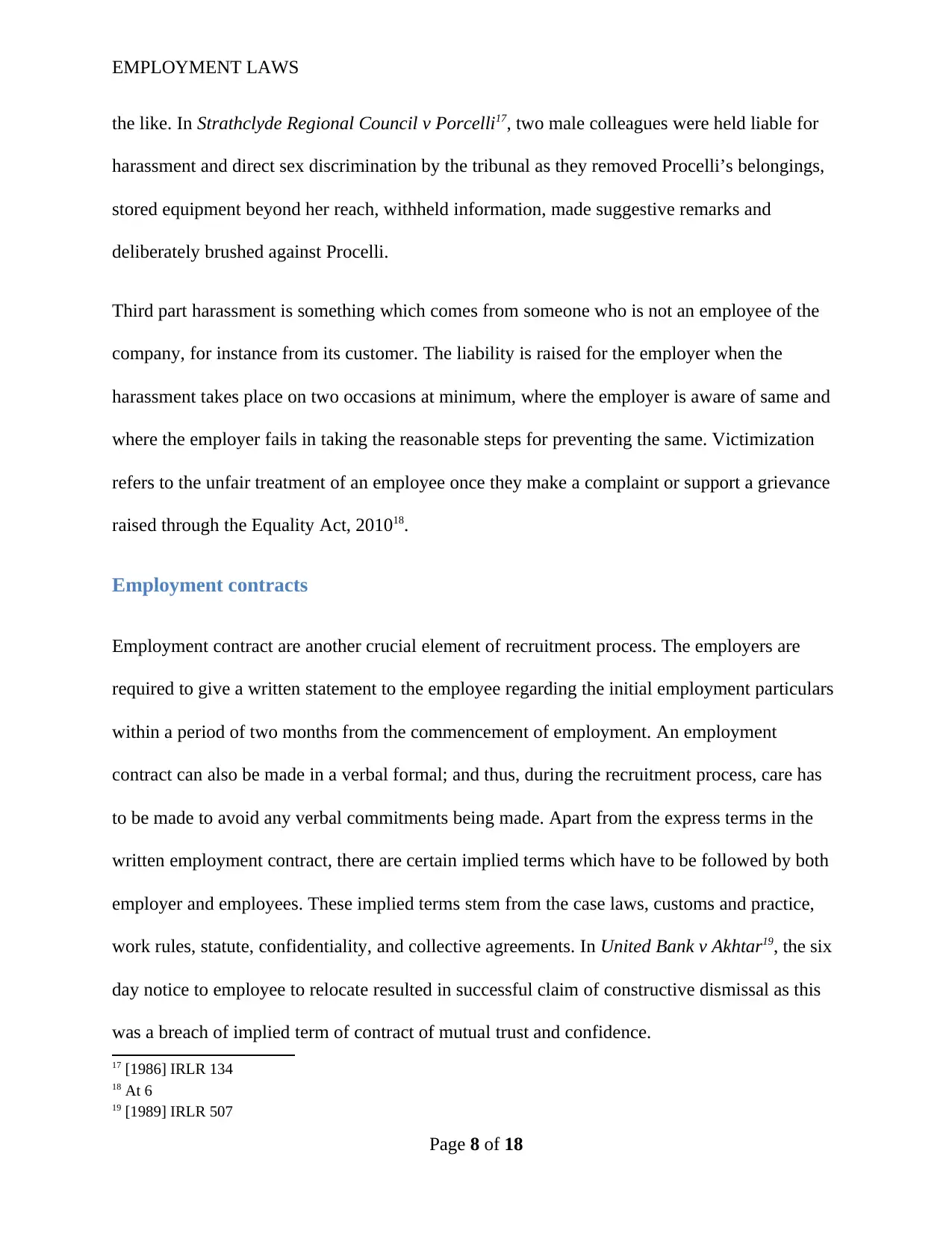
EMPLOYMENT LAWS
the like. In Strathclyde Regional Council v Porcelli17, two male colleagues were held liable for
harassment and direct sex discrimination by the tribunal as they removed Procelli’s belongings,
stored equipment beyond her reach, withheld information, made suggestive remarks and
deliberately brushed against Procelli.
Third part harassment is something which comes from someone who is not an employee of the
company, for instance from its customer. The liability is raised for the employer when the
harassment takes place on two occasions at minimum, where the employer is aware of same and
where the employer fails in taking the reasonable steps for preventing the same. Victimization
refers to the unfair treatment of an employee once they make a complaint or support a grievance
raised through the Equality Act, 201018.
Employment contracts
Employment contract are another crucial element of recruitment process. The employers are
required to give a written statement to the employee regarding the initial employment particulars
within a period of two months from the commencement of employment. An employment
contract can also be made in a verbal formal; and thus, during the recruitment process, care has
to be made to avoid any verbal commitments being made. Apart from the express terms in the
written employment contract, there are certain implied terms which have to be followed by both
employer and employees. These implied terms stem from the case laws, customs and practice,
work rules, statute, confidentiality, and collective agreements. In United Bank v Akhtar19, the six
day notice to employee to relocate resulted in successful claim of constructive dismissal as this
was a breach of implied term of contract of mutual trust and confidence.
17 [1986] IRLR 134
18 At 6
19 [1989] IRLR 507
Page 8 of 18
the like. In Strathclyde Regional Council v Porcelli17, two male colleagues were held liable for
harassment and direct sex discrimination by the tribunal as they removed Procelli’s belongings,
stored equipment beyond her reach, withheld information, made suggestive remarks and
deliberately brushed against Procelli.
Third part harassment is something which comes from someone who is not an employee of the
company, for instance from its customer. The liability is raised for the employer when the
harassment takes place on two occasions at minimum, where the employer is aware of same and
where the employer fails in taking the reasonable steps for preventing the same. Victimization
refers to the unfair treatment of an employee once they make a complaint or support a grievance
raised through the Equality Act, 201018.
Employment contracts
Employment contract are another crucial element of recruitment process. The employers are
required to give a written statement to the employee regarding the initial employment particulars
within a period of two months from the commencement of employment. An employment
contract can also be made in a verbal formal; and thus, during the recruitment process, care has
to be made to avoid any verbal commitments being made. Apart from the express terms in the
written employment contract, there are certain implied terms which have to be followed by both
employer and employees. These implied terms stem from the case laws, customs and practice,
work rules, statute, confidentiality, and collective agreements. In United Bank v Akhtar19, the six
day notice to employee to relocate resulted in successful claim of constructive dismissal as this
was a breach of implied term of contract of mutual trust and confidence.
17 [1986] IRLR 134
18 At 6
19 [1989] IRLR 507
Page 8 of 18
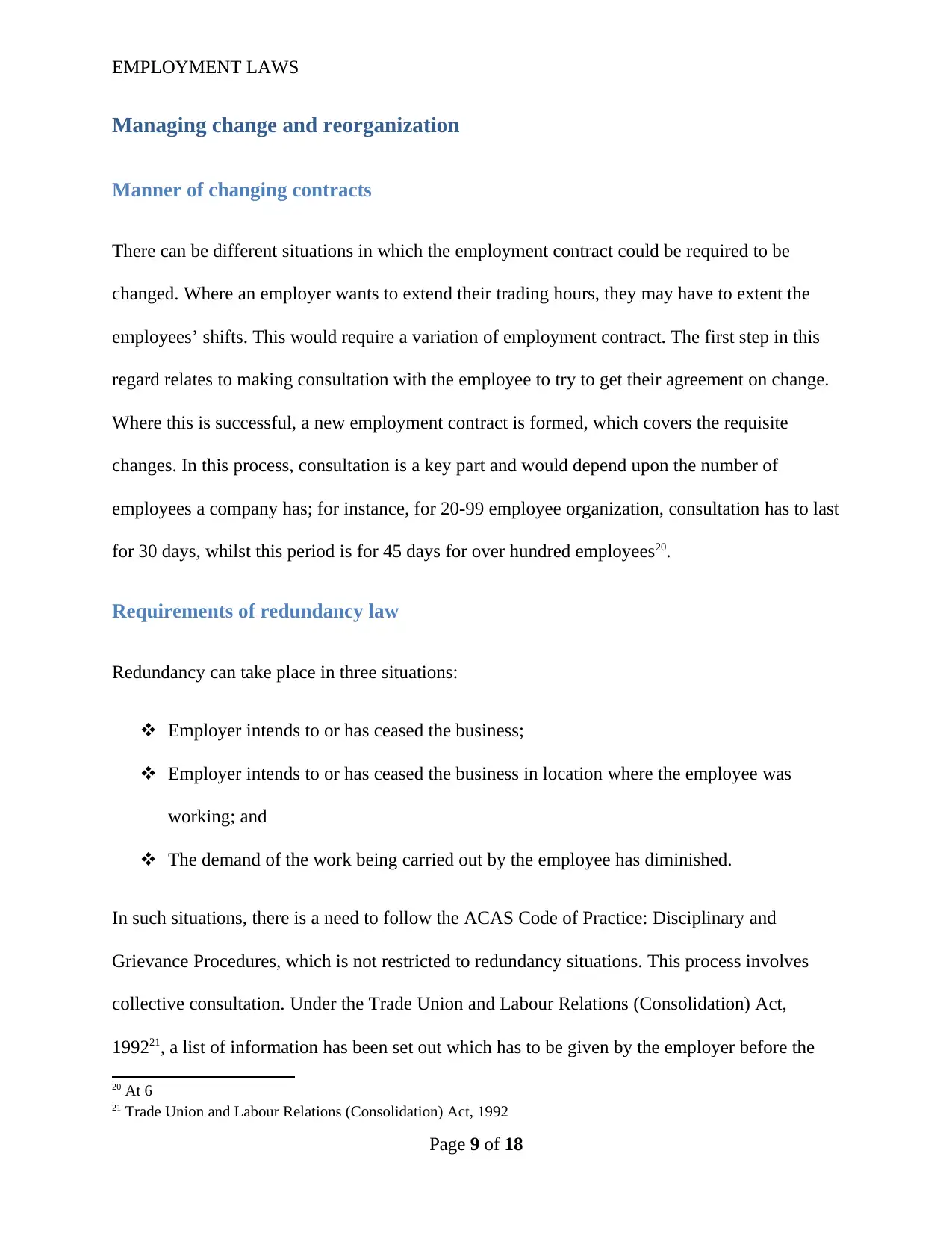
EMPLOYMENT LAWS
Managing change and reorganization
Manner of changing contracts
There can be different situations in which the employment contract could be required to be
changed. Where an employer wants to extend their trading hours, they may have to extent the
employees’ shifts. This would require a variation of employment contract. The first step in this
regard relates to making consultation with the employee to try to get their agreement on change.
Where this is successful, a new employment contract is formed, which covers the requisite
changes. In this process, consultation is a key part and would depend upon the number of
employees a company has; for instance, for 20-99 employee organization, consultation has to last
for 30 days, whilst this period is for 45 days for over hundred employees20.
Requirements of redundancy law
Redundancy can take place in three situations:
Employer intends to or has ceased the business;
Employer intends to or has ceased the business in location where the employee was
working; and
The demand of the work being carried out by the employee has diminished.
In such situations, there is a need to follow the ACAS Code of Practice: Disciplinary and
Grievance Procedures, which is not restricted to redundancy situations. This process involves
collective consultation. Under the Trade Union and Labour Relations (Consolidation) Act,
199221, a list of information has been set out which has to be given by the employer before the
20 At 6
21 Trade Union and Labour Relations (Consolidation) Act, 1992
Page 9 of 18
Managing change and reorganization
Manner of changing contracts
There can be different situations in which the employment contract could be required to be
changed. Where an employer wants to extend their trading hours, they may have to extent the
employees’ shifts. This would require a variation of employment contract. The first step in this
regard relates to making consultation with the employee to try to get their agreement on change.
Where this is successful, a new employment contract is formed, which covers the requisite
changes. In this process, consultation is a key part and would depend upon the number of
employees a company has; for instance, for 20-99 employee organization, consultation has to last
for 30 days, whilst this period is for 45 days for over hundred employees20.
Requirements of redundancy law
Redundancy can take place in three situations:
Employer intends to or has ceased the business;
Employer intends to or has ceased the business in location where the employee was
working; and
The demand of the work being carried out by the employee has diminished.
In such situations, there is a need to follow the ACAS Code of Practice: Disciplinary and
Grievance Procedures, which is not restricted to redundancy situations. This process involves
collective consultation. Under the Trade Union and Labour Relations (Consolidation) Act,
199221, a list of information has been set out which has to be given by the employer before the
20 At 6
21 Trade Union and Labour Relations (Consolidation) Act, 1992
Page 9 of 18
⊘ This is a preview!⊘
Do you want full access?
Subscribe today to unlock all pages.

Trusted by 1+ million students worldwide
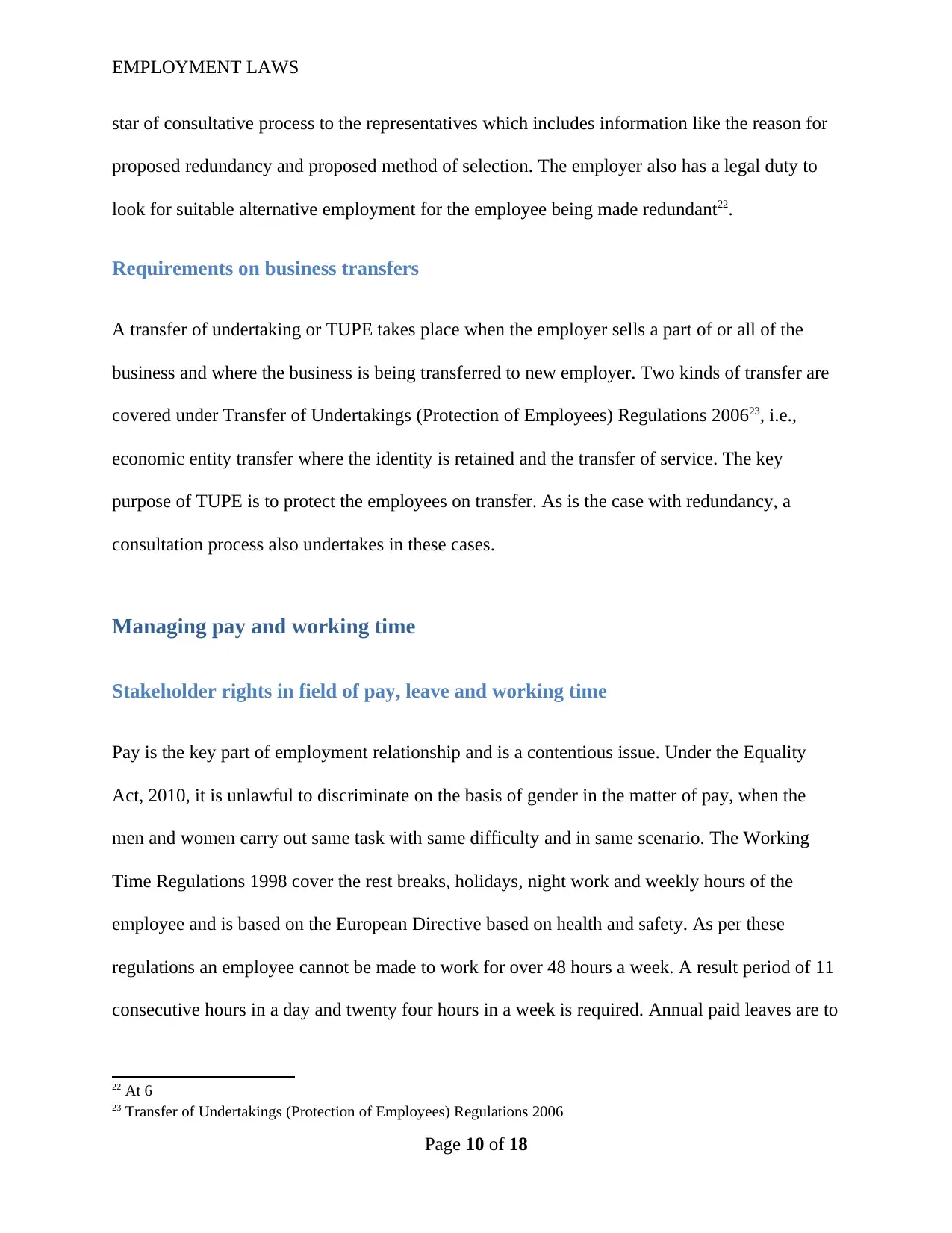
EMPLOYMENT LAWS
star of consultative process to the representatives which includes information like the reason for
proposed redundancy and proposed method of selection. The employer also has a legal duty to
look for suitable alternative employment for the employee being made redundant22.
Requirements on business transfers
A transfer of undertaking or TUPE takes place when the employer sells a part of or all of the
business and where the business is being transferred to new employer. Two kinds of transfer are
covered under Transfer of Undertakings (Protection of Employees) Regulations 200623, i.e.,
economic entity transfer where the identity is retained and the transfer of service. The key
purpose of TUPE is to protect the employees on transfer. As is the case with redundancy, a
consultation process also undertakes in these cases.
Managing pay and working time
Stakeholder rights in field of pay, leave and working time
Pay is the key part of employment relationship and is a contentious issue. Under the Equality
Act, 2010, it is unlawful to discriminate on the basis of gender in the matter of pay, when the
men and women carry out same task with same difficulty and in same scenario. The Working
Time Regulations 1998 cover the rest breaks, holidays, night work and weekly hours of the
employee and is based on the European Directive based on health and safety. As per these
regulations an employee cannot be made to work for over 48 hours a week. A result period of 11
consecutive hours in a day and twenty four hours in a week is required. Annual paid leaves are to
22 At 6
23 Transfer of Undertakings (Protection of Employees) Regulations 2006
Page 10 of 18
star of consultative process to the representatives which includes information like the reason for
proposed redundancy and proposed method of selection. The employer also has a legal duty to
look for suitable alternative employment for the employee being made redundant22.
Requirements on business transfers
A transfer of undertaking or TUPE takes place when the employer sells a part of or all of the
business and where the business is being transferred to new employer. Two kinds of transfer are
covered under Transfer of Undertakings (Protection of Employees) Regulations 200623, i.e.,
economic entity transfer where the identity is retained and the transfer of service. The key
purpose of TUPE is to protect the employees on transfer. As is the case with redundancy, a
consultation process also undertakes in these cases.
Managing pay and working time
Stakeholder rights in field of pay, leave and working time
Pay is the key part of employment relationship and is a contentious issue. Under the Equality
Act, 2010, it is unlawful to discriminate on the basis of gender in the matter of pay, when the
men and women carry out same task with same difficulty and in same scenario. The Working
Time Regulations 1998 cover the rest breaks, holidays, night work and weekly hours of the
employee and is based on the European Directive based on health and safety. As per these
regulations an employee cannot be made to work for over 48 hours a week. A result period of 11
consecutive hours in a day and twenty four hours in a week is required. Annual paid leaves are to
22 At 6
23 Transfer of Undertakings (Protection of Employees) Regulations 2006
Page 10 of 18
Paraphrase This Document
Need a fresh take? Get an instant paraphrase of this document with our AI Paraphraser
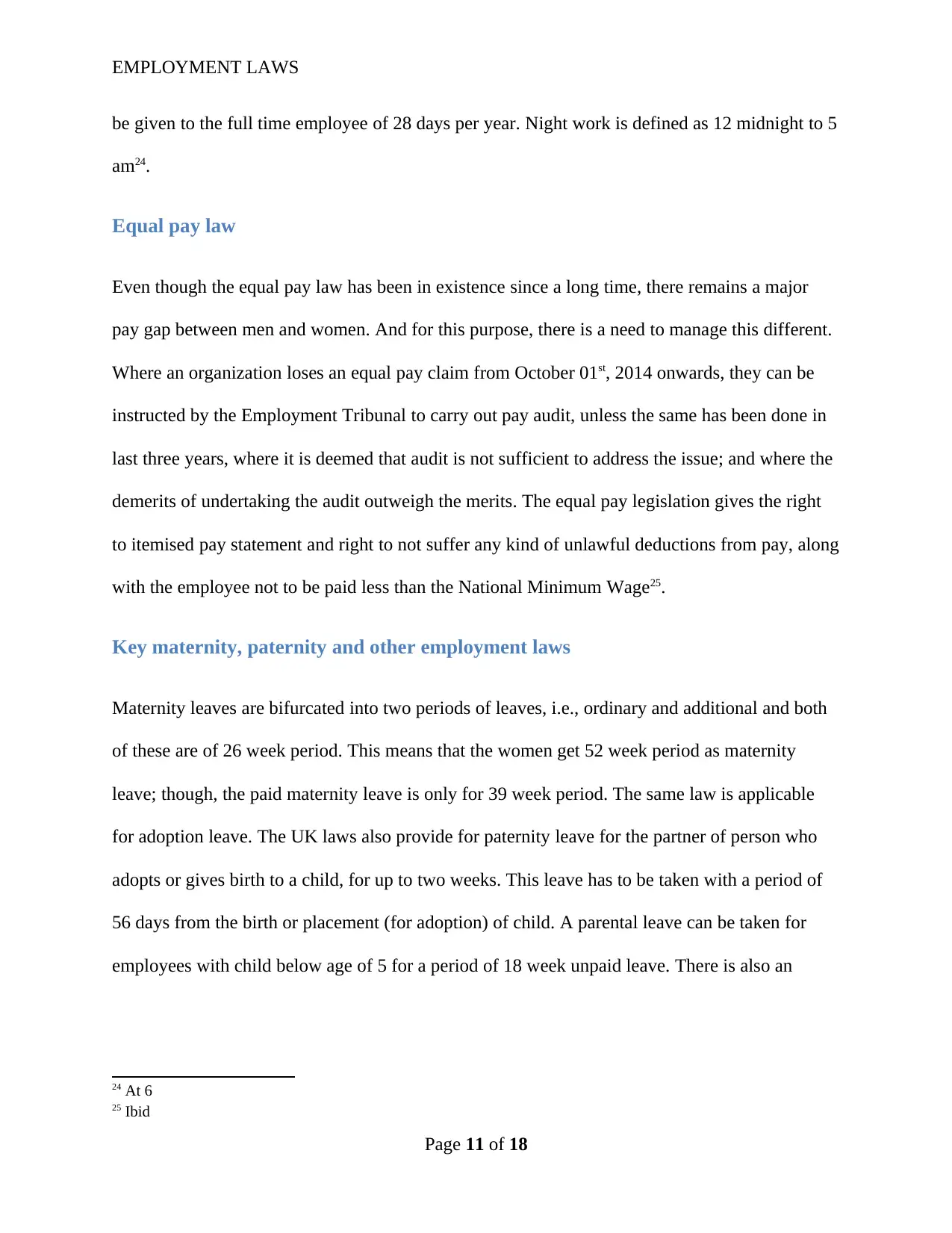
EMPLOYMENT LAWS
be given to the full time employee of 28 days per year. Night work is defined as 12 midnight to 5
am24.
Equal pay law
Even though the equal pay law has been in existence since a long time, there remains a major
pay gap between men and women. And for this purpose, there is a need to manage this different.
Where an organization loses an equal pay claim from October 01st, 2014 onwards, they can be
instructed by the Employment Tribunal to carry out pay audit, unless the same has been done in
last three years, where it is deemed that audit is not sufficient to address the issue; and where the
demerits of undertaking the audit outweigh the merits. The equal pay legislation gives the right
to itemised pay statement and right to not suffer any kind of unlawful deductions from pay, along
with the employee not to be paid less than the National Minimum Wage25.
Key maternity, paternity and other employment laws
Maternity leaves are bifurcated into two periods of leaves, i.e., ordinary and additional and both
of these are of 26 week period. This means that the women get 52 week period as maternity
leave; though, the paid maternity leave is only for 39 week period. The same law is applicable
for adoption leave. The UK laws also provide for paternity leave for the partner of person who
adopts or gives birth to a child, for up to two weeks. This leave has to be taken with a period of
56 days from the birth or placement (for adoption) of child. A parental leave can be taken for
employees with child below age of 5 for a period of 18 week unpaid leave. There is also an
24 At 6
25 Ibid
Page 11 of 18
be given to the full time employee of 28 days per year. Night work is defined as 12 midnight to 5
am24.
Equal pay law
Even though the equal pay law has been in existence since a long time, there remains a major
pay gap between men and women. And for this purpose, there is a need to manage this different.
Where an organization loses an equal pay claim from October 01st, 2014 onwards, they can be
instructed by the Employment Tribunal to carry out pay audit, unless the same has been done in
last three years, where it is deemed that audit is not sufficient to address the issue; and where the
demerits of undertaking the audit outweigh the merits. The equal pay legislation gives the right
to itemised pay statement and right to not suffer any kind of unlawful deductions from pay, along
with the employee not to be paid less than the National Minimum Wage25.
Key maternity, paternity and other employment laws
Maternity leaves are bifurcated into two periods of leaves, i.e., ordinary and additional and both
of these are of 26 week period. This means that the women get 52 week period as maternity
leave; though, the paid maternity leave is only for 39 week period. The same law is applicable
for adoption leave. The UK laws also provide for paternity leave for the partner of person who
adopts or gives birth to a child, for up to two weeks. This leave has to be taken with a period of
56 days from the birth or placement (for adoption) of child. A parental leave can be taken for
employees with child below age of 5 for a period of 18 week unpaid leave. There is also an
24 At 6
25 Ibid
Page 11 of 18
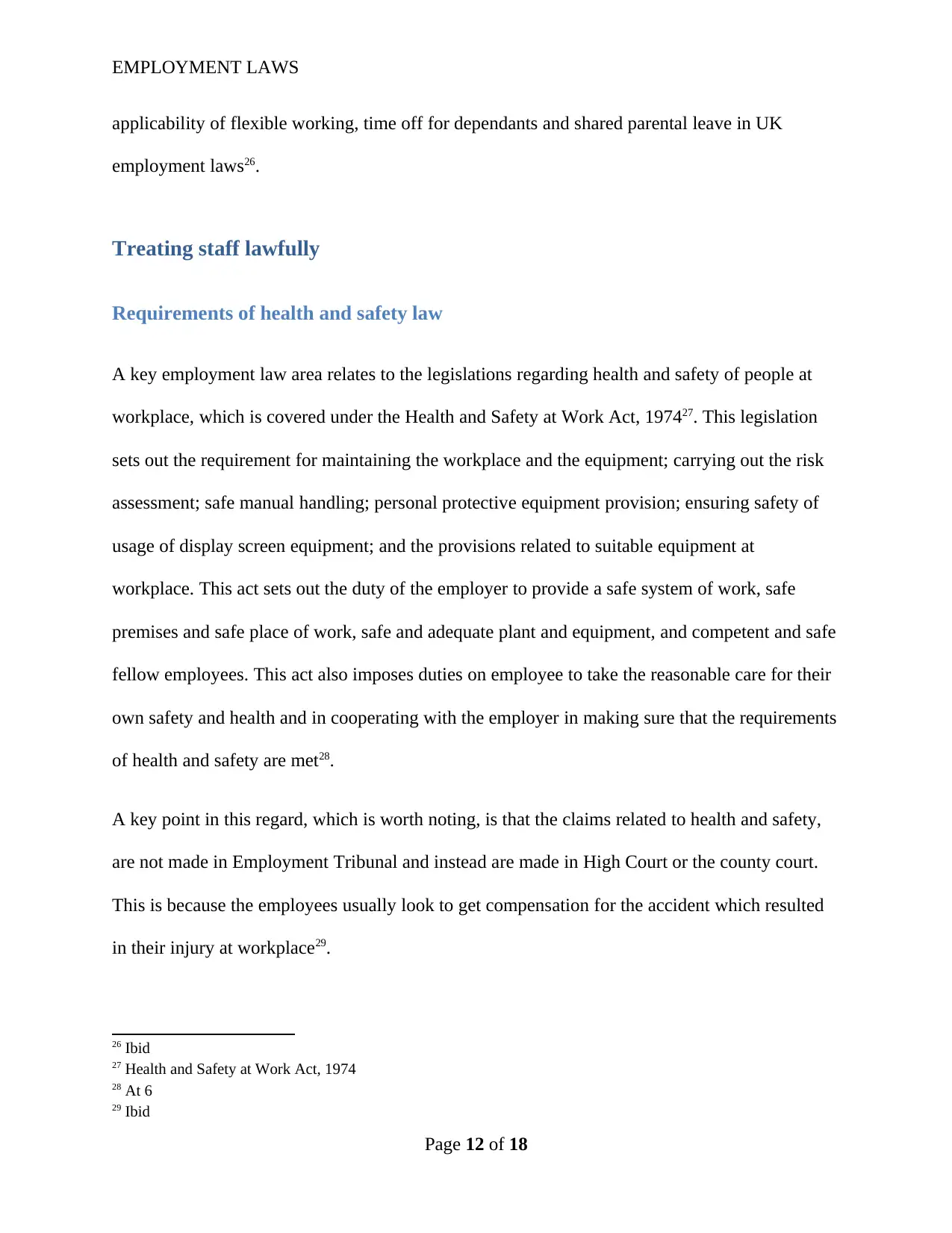
EMPLOYMENT LAWS
applicability of flexible working, time off for dependants and shared parental leave in UK
employment laws26.
Treating staff lawfully
Requirements of health and safety law
A key employment law area relates to the legislations regarding health and safety of people at
workplace, which is covered under the Health and Safety at Work Act, 197427. This legislation
sets out the requirement for maintaining the workplace and the equipment; carrying out the risk
assessment; safe manual handling; personal protective equipment provision; ensuring safety of
usage of display screen equipment; and the provisions related to suitable equipment at
workplace. This act sets out the duty of the employer to provide a safe system of work, safe
premises and safe place of work, safe and adequate plant and equipment, and competent and safe
fellow employees. This act also imposes duties on employee to take the reasonable care for their
own safety and health and in cooperating with the employer in making sure that the requirements
of health and safety are met28.
A key point in this regard, which is worth noting, is that the claims related to health and safety,
are not made in Employment Tribunal and instead are made in High Court or the county court.
This is because the employees usually look to get compensation for the accident which resulted
in their injury at workplace29.
26 Ibid
27 Health and Safety at Work Act, 1974
28 At 6
29 Ibid
Page 12 of 18
applicability of flexible working, time off for dependants and shared parental leave in UK
employment laws26.
Treating staff lawfully
Requirements of health and safety law
A key employment law area relates to the legislations regarding health and safety of people at
workplace, which is covered under the Health and Safety at Work Act, 197427. This legislation
sets out the requirement for maintaining the workplace and the equipment; carrying out the risk
assessment; safe manual handling; personal protective equipment provision; ensuring safety of
usage of display screen equipment; and the provisions related to suitable equipment at
workplace. This act sets out the duty of the employer to provide a safe system of work, safe
premises and safe place of work, safe and adequate plant and equipment, and competent and safe
fellow employees. This act also imposes duties on employee to take the reasonable care for their
own safety and health and in cooperating with the employer in making sure that the requirements
of health and safety are met28.
A key point in this regard, which is worth noting, is that the claims related to health and safety,
are not made in Employment Tribunal and instead are made in High Court or the county court.
This is because the employees usually look to get compensation for the accident which resulted
in their injury at workplace29.
26 Ibid
27 Health and Safety at Work Act, 1974
28 At 6
29 Ibid
Page 12 of 18
⊘ This is a preview!⊘
Do you want full access?
Subscribe today to unlock all pages.

Trusted by 1+ million students worldwide
1 out of 18
Related Documents
Your All-in-One AI-Powered Toolkit for Academic Success.
+13062052269
info@desklib.com
Available 24*7 on WhatsApp / Email
![[object Object]](/_next/static/media/star-bottom.7253800d.svg)
Unlock your academic potential
Copyright © 2020–2025 A2Z Services. All Rights Reserved. Developed and managed by ZUCOL.





